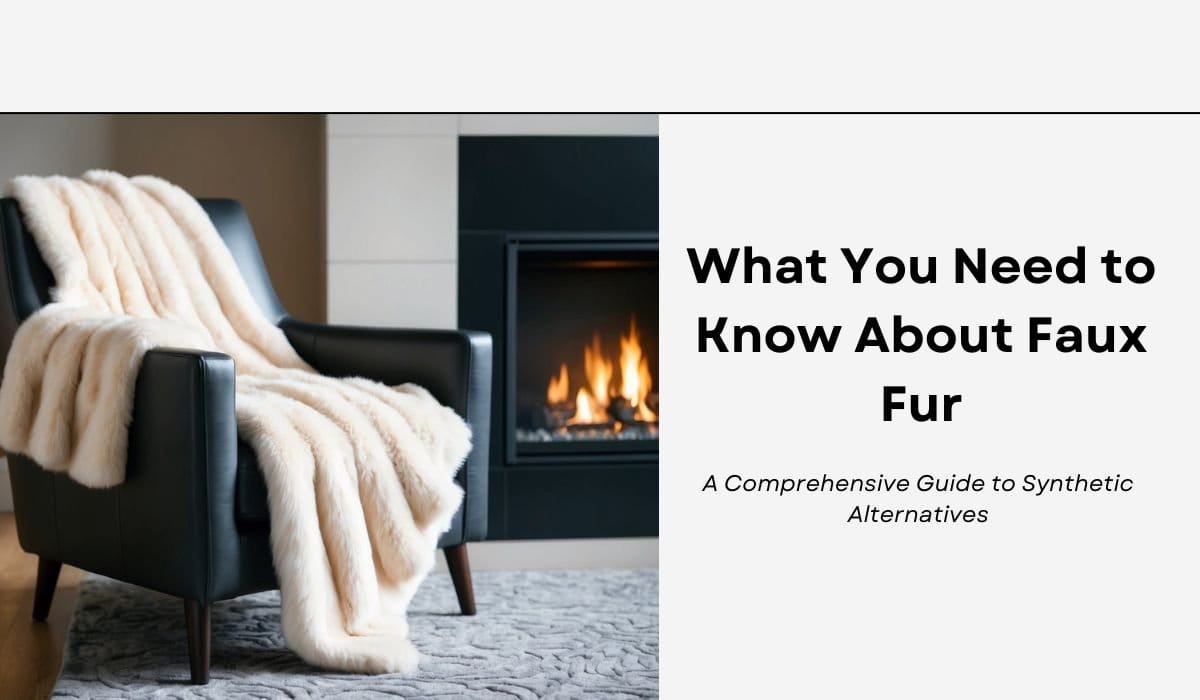From Texture to Care: Understanding the Modern Evolution of Cruelty-Free Fashion
Faux fur has taken the fashion world by storm. This man-made fabric aims to mimic the look and feel of animal fur without harming animals. It’s typically made from synthetic fibres and has become a popular choice for those seeking cruelty-free alternatives.
Faux fur offers a way to enjoy the luxurious look of fur without the ethical concerns associated with real animal fur. It comes in a variety of textures, colours, and styles, making it a versatile option for fashion designers and consumers alike. From coats and accessories to home decor, faux fur has found its way into many aspects of our lives.
While faux fur has its benefits, it’s important to consider its environmental impact. As a synthetic material, it may not be biodegradable and could contribute to microplastic pollution. When choosing faux fur, it’s worth looking into eco-friendly options and considering the product’s longevity.
On This Page
Key Takeaways
- Faux fur is a synthetic alternative to animal fur, offering a cruelty-free option for fashion and decor
- The quality and appearance of faux fur have improved significantly, making it a popular choice in the fashion industry
- While faux fur addresses ethical concerns, its environmental impact should be considered when making purchasing decisions
The Essence of Faux Fur
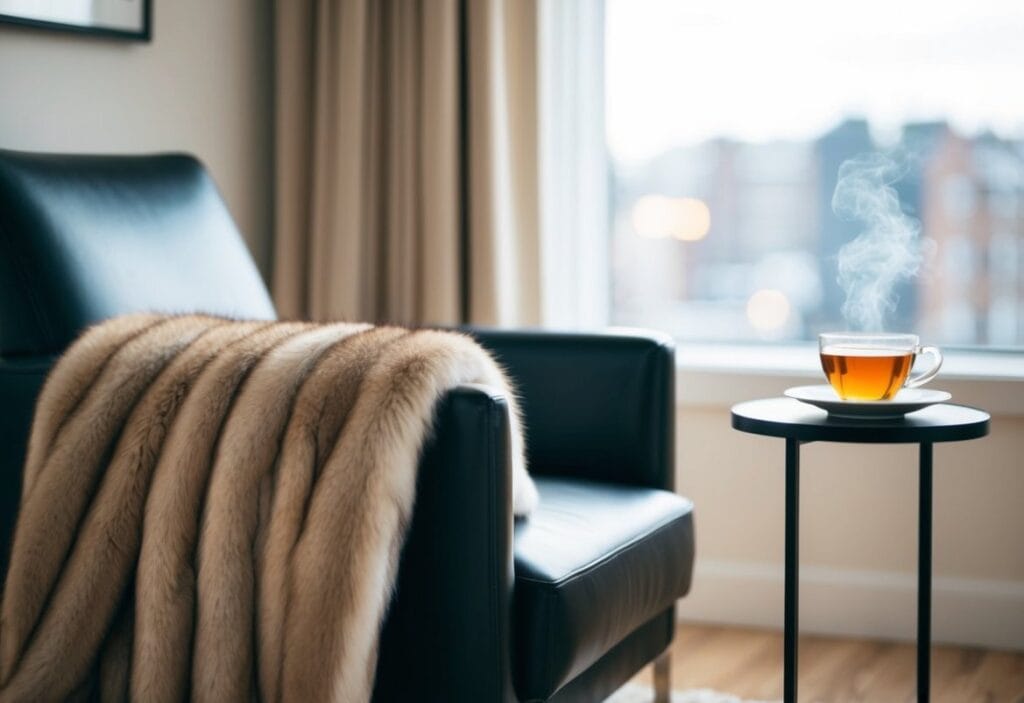
Faux fur is a synthetic fabric designed to mimic animal fur. It offers a cruelty-free alternative to real fur, with varying textures and styles.
Understanding Faux Fur and Its Varieties
Faux fur is typically made from synthetic fibres like acrylic, polyester, or modacrylic. These materials are woven or knitted to create a soft, furry texture.
Faux fur comes in many varieties, ranging from short and plush to long and shaggy. Some types aim to replicate specific animal furs, while others have unique textures and colours.
High-quality faux fur can be quite luxurious, with a realistic appearance and feel. Advances in textile technology have led to increasingly sophisticated faux furs that closely mimic natural animal fur.
Comparing Faux Fur to Real Animal Fur
Faux fur and real animal fur have distinct differences. Real fur has a natural leather base with fur hairs attached, while fake fur has a knitted or woven base.
Faux fur is generally more affordable and easier to care for than real fur. It’s also more versatile in terms of colour and texture options.
Animal fur is often warmer and more durable, but faux fur has improved greatly in these areas. Many people choose faux fur for ethical reasons, as it doesn’t involve animal cruelty.
Modern faux fur can be quite convincing, making it difficult to distinguish from real fur at first glance.
Faux Fur Fabrication
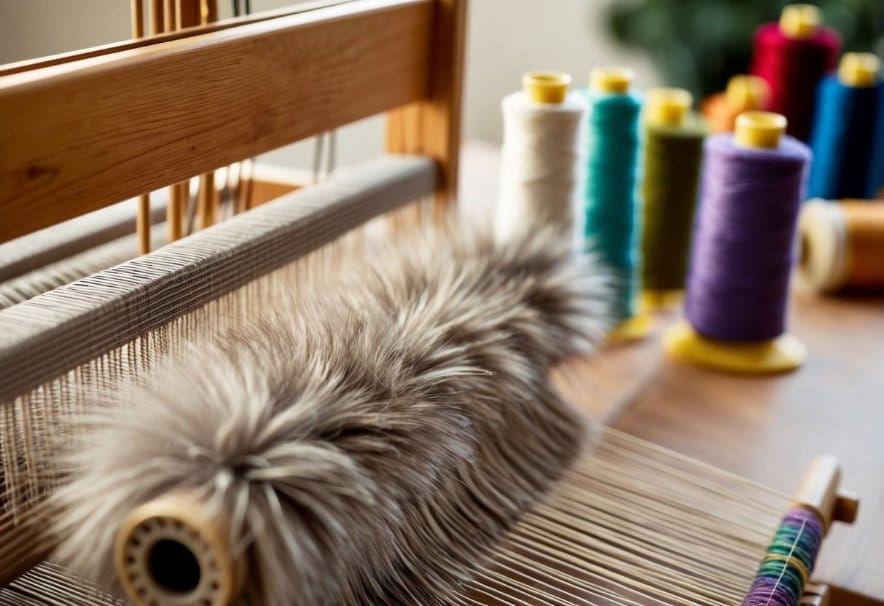
Faux fur is made using synthetic materials and chemical processes. These methods aim to replicate the look and feel of real animal fur.
Materials Used in Faux Fur Production
Faux fur fabric is typically made from synthetic fibres. The most common materials are acrylic and polyester. Acrylic fibres are lightweight and soft, making them ideal for mimicking fine animal furs.
Polyester is durable and less expensive, often used for thicker faux furs. Some manufacturers now use recycled polyester to improve sustainability.
Modacrylic fibres are sometimes added to enhance fire resistance. The synthetic fibres are attached to a backing material, usually made of polyester or cotton.
Environmental Impact and Toxic Chemicals
Faux fur production can have significant environmental effects. The process uses non-renewable resources and energy-intensive methods.
Toxic chemicals are often employed in manufacturing. These may include plasticisers, dyes, and flame retardants. Some of these substances can harm workers and pollute waterways.
Synthetic fabrics also shed microplastics when washed. These tiny particles can enter ecosystems and pose risks to wildlife. However, faux fur does not require animal farming, which can reduce land use and methane emissions.
Ethical Perspectives
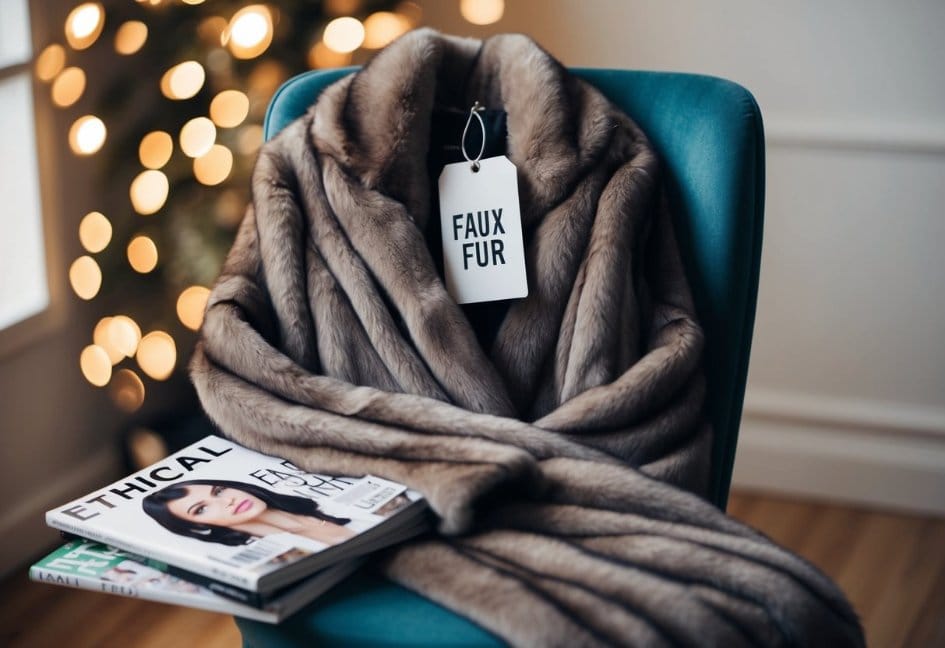
Faux fur raises important ethical questions around animal welfare and sustainable fashion. It offers an alternative to real fur but comes with its own set of considerations.
Animal Cruelty Concerns
Real fur production often involves inhumane treatment of animals. Animals may be kept in small cages and killed using cruel methods. This has led many to seek alternatives that don’t harm animals.
Faux fur provides a way to achieve a similar look without animal suffering. It allows fashion lovers to enjoy fur-like styles whilst avoiding ethical issues tied to animal fur.
Some argue faux fur normalises the fur look, potentially increasing demand for real fur. Others see it as a positive step away from animal use in fashion.
Cruelty-Free Alternatives
Faux fur offers a cruelty-free option for those who want the fur aesthetic. It’s made from synthetic fibres rather than animal pelts. This eliminates animal welfare concerns associated with fur farming and trapping.
Many faux furs are made from plastics like polyester. These materials have their own environmental impacts. They’re not biodegradable and can shed microfibres.
Some brands are developing more eco-friendly faux fur options. These include recycled plastics and plant-based materials. These aim to address both animal welfare and sustainability concerns.
Consumers can look for high-quality faux furs that shed less and last longer. This helps reduce environmental impact whilst still avoiding animal cruelty.
Faux Fur in Fashion
Faux fur has become a staple in modern fashion. It offers a cruelty-free way to enjoy the luxury look of fur without harming animals.
Key Players and Fashion Designers
Stella McCartney stands out as a pioneer in using faux fur. Her designs showcase how artificial fur can be both stylish and ethical.
Gucci has also embraced faux fur, dropping real fur from their collections. This move by a major luxury brand helped boost faux fur’s image.
Other designers like Prada have created realistic faux fur pieces. These high-end offerings have made synthetic fur more desirable in fashion circles.
Faux Fur’s Role as a Fashion Statement
Faux fur jackets and coats have become popular fashion items. They offer warmth and style without the ethical concerns of real fur.
Faux fur accessories like hats, scarves, and bag trims are also trendy. These pieces add a touch of glamour to outfits.
The faux fur industry has grown as demand increased. It now offers a wide range of textures and colours to suit different styles.
Wearing faux fur has become a way to show support for animal rights. It allows fashion lovers to enjoy fur’s look while aligning with their values.
Quality and Care of Faux Fur
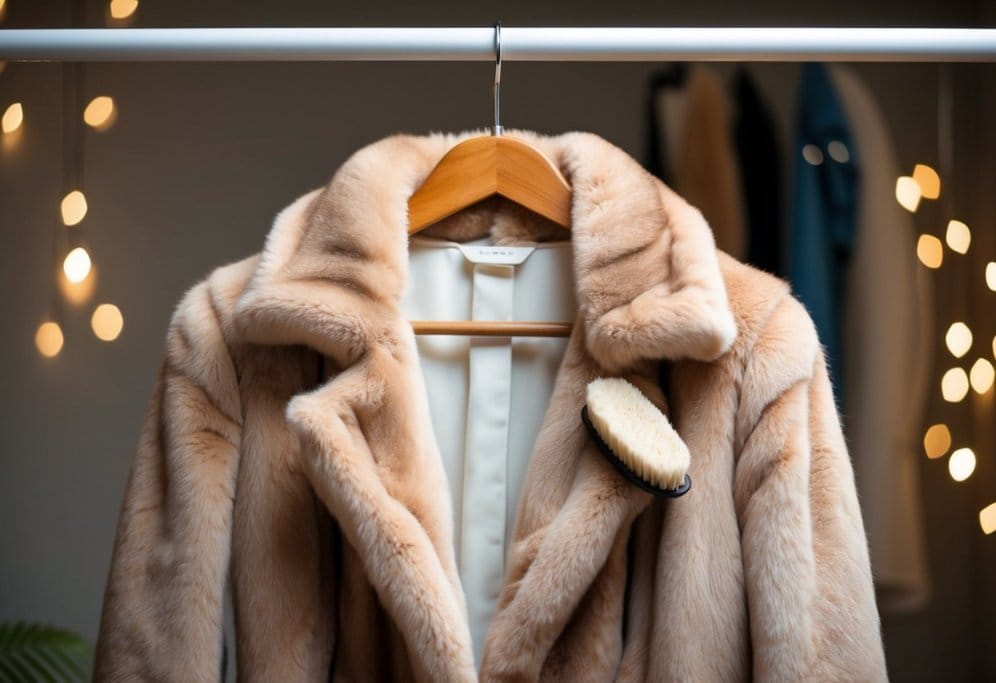
Faux fur comes in different types and requires proper care to maintain its look and feel. Knowing how to choose quality faux fur and care for it properly helps ensure your items stay beautiful for years to come.
Different Types: Short Pile and Long Pile Faux Furs
Short pile faux fur has a smooth, velvety texture with fibres typically less than 1 cm long. It’s often used for accessories and trims. Long pile faux fur has fibres over 2 cm long, creating a fluffy, luxurious look similar to real animal fur.
Quality faux fur should feel soft and warm to the touch. Poor quality versions may feel rough or plasticky. When shopping, run your fingers through the pile to check for softness and density.
Durability varies between types. Short pile tends to be more resilient, while long pile may require extra care to prevent matting. High-quality faux furs maintain their texture even after repeated cleaning.
Maintaining and Cleaning Faux Fur Products
Proper care keeps faux fur looking its best. Brush faux fur regularly with a soft-bristled brush to prevent tangling and restore volume. Be gentle to avoid damaging fibres.
Store faux fur items in a cool, dry place away from direct sunlight. Use breathable garment bags to protect from dust while allowing air circulation.
For cleaning, check the care label first. Many faux fur items are dry clean only. If machine washable, use cold water and a gentle cycle. Air dry and brush when damp to restore texture.
Avoid getting faux fur wet. If it gets damp, gently blot with a towel and let air dry. Never use heat to dry faux fur as it can melt or damage the fibres.
Innovation in Faux Fur
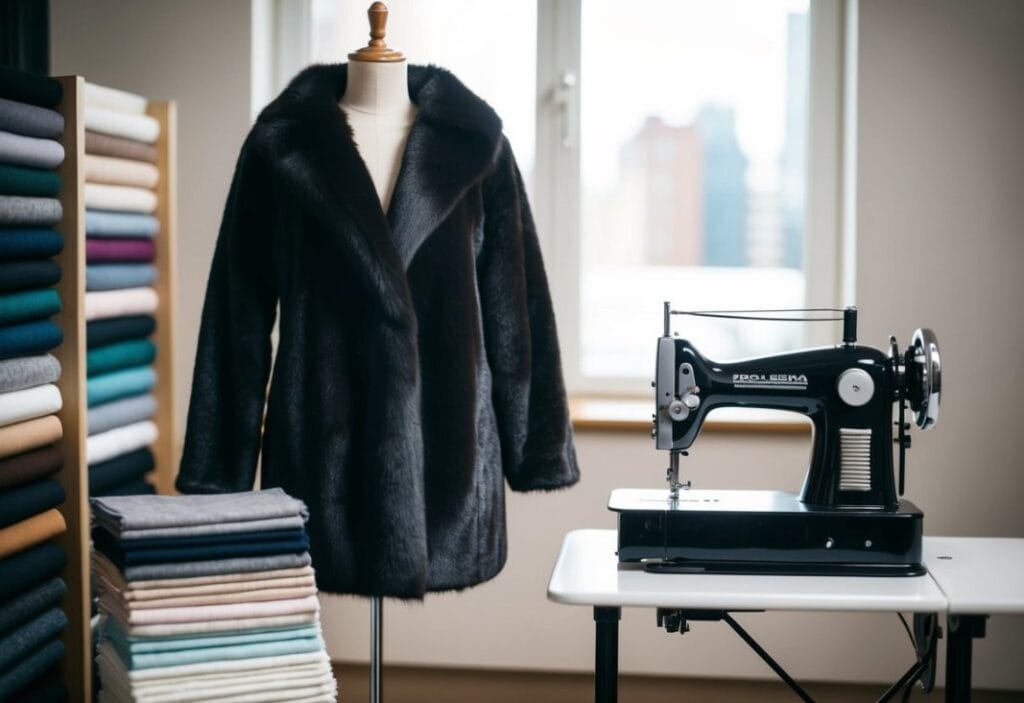
New materials and technologies are changing faux fur. These advances make it more eco-friendly and realistic.
Biodegradable and Sustainable Materials
Eco-friendly faux fur is now a reality. Some makers use plant-based fibres like corn or hemp. These break down in nature, unlike plastic-based faux fur.
Other firms recycle plastic bottles into faux fur. This keeps waste out of landfills. New dyes use less water and energy too.
Some brands blend natural and fake fibres. This creates a more authentic feel. Wool faux fur offers warmth and breathability. It’s also less harmful to the planet.
Technological Advancements in Faux Fur
3D printing helps create more realistic faux fur. It can mimic real animal fur patterns closely. This makes faux fur look and feel more genuine.
New machines can weave finer, softer fibres. The result is high-quality faux fur that’s hard to tell from real fur. Some even have varied fibre lengths, just like real fur.
Heat-moulding techniques shape faux fur into complex styles. This allows for more diverse designs in fashion and home goods.
Broader Applications
Faux fur has expanded beyond clothing into home decor and accessories. Its versatility and appealing texture make it popular for various uses.
Faux Fur in Home Decor
Faux fur adds warmth and luxury to living spaces. Faux fur blankets are cosy additions to sofas and beds, providing comfort without ethical concerns. Throw pillows with faux fur covers create a plush, inviting atmosphere in sitting areas.
Rugs made of synthetic fur bring a touch of opulence to floors. They are especially popular in bedrooms and living rooms, offering a soft surface underfoot.
Faux fur can also serve as unexpected wall decor. Panels or tapestries made from this material add texture and visual interest to plain walls.
Faux Fur Beyond Clothing
Faux fur has found its way into fashion accessories. Handbags and purses with faux fur accents or linings are trendy options for adding a luxe feel to outfits.
Faux fur shoes, such as slippers and boots, provide warmth and style. These items are particularly popular in colder climates.
Shawls and scarves made from synthetic fur offer both fashion and function. They keep wearers warm while adding a sophisticated touch to winter ensembles.
Faux fur is also used in unexpected places like car seat covers and pet beds. Its soft texture and easy maintenance make it ideal for these applications.
The Future Outlook
The faux fur industry is poised for significant changes. Sustainable fashion trends and new innovations are shaping its direction.
Predictions for the Faux Fur Market
The faux fur market is set to grow. By 2030, experts expect it to reach £20 billion globally. This growth stems from rising demand for cruelty-free products.
New materials are emerging. Bio-based faux furs made from plant fibres are gaining traction. These offer a more eco-friendly option.
Designers are getting creative. We’re seeing faux fur mixed with other fabrics. Denim fur, a blend of recycled denim and faux fur, is one example.
Quality is improving. Modern faux furs look and feel more like real fur than ever. This appeals to luxury brands and consumers alike.
Societal Shifts and Faux Fur
Public opinion is changing. More people now favour animal-free fashion. This shift is pushing brands to adopt faux fur.
Celebrities are influencing trends. Many are publicly supporting faux fur, boosting its popularity.
Laws are evolving too. Some countries have banned fur farming. Others are considering similar measures. This could further increase demand for faux alternatives.
Sustainable fashion is a growing concern. Consumers want eco-friendly options. The faux fur industry is responding with more sustainable production methods.
Education is key. As people learn about the benefits of faux fur, its acceptance grows. This trend is likely to continue in the coming years.
Frequently Asked Questions
Faux fur has become a popular alternative to real fur in fashion. Many people have questions about its production, care, and environmental impact.
How is faux fur produced?
Faux fur is typically made from synthetic fibres. These fibres are woven or knitted into a fabric base. The result mimics the look and feel of animal fur.
Some newer faux furs use plant-based materials. For example, ECOPEL has developed a faux fur using corn-derived fibres.
What are the care instructions for maintaining faux fur garments?
Faux fur requires gentle care to maintain its appearance. Most items can be hand-washed or dry-cleaned.
Avoid using heat when drying, as this can damage the fibres. Instead, air-dry the garment and brush it gently to restore its fluffy texture.
What are the environmental impacts of faux fur compared to real fur?
Faux fur has both positive and negative environmental impacts. It doesn’t involve animal cruelty, which is a significant benefit.
However, many faux furs are made from non-biodegradable synthetic materials. These can shed microfibres and contribute to plastic pollution.
How can one identify high-quality faux fur?
High-quality faux fur should have a soft, plush feel. Check the base of the fabric. Faux fur will have a knitted base, while real fur has a leather base.
Look for even colouring and consistent texture. High-quality faux fur should not shed excessively when gently pulled.
Can faux fur be considered a sustainable alternative to real fur?
The sustainability of faux fur is debatable. It doesn’t harm animals, which is a plus for many consumers.
But most faux furs are made from synthetic materials derived from petroleum. Some brands are developing more sustainable options using plant-based fibres.
What should be done if a faux fur item becomes damp or wet?
If a faux fur item gets wet, gently squeeze out excess water. Don’t wring or twist the fabric, as this can damage it.
Let the item air-dry naturally. Once dry, use a soft brush to restore the fur’s texture and fluffiness.
Related Post: Fabric 101: Essential Guide to Textiles and Materials

